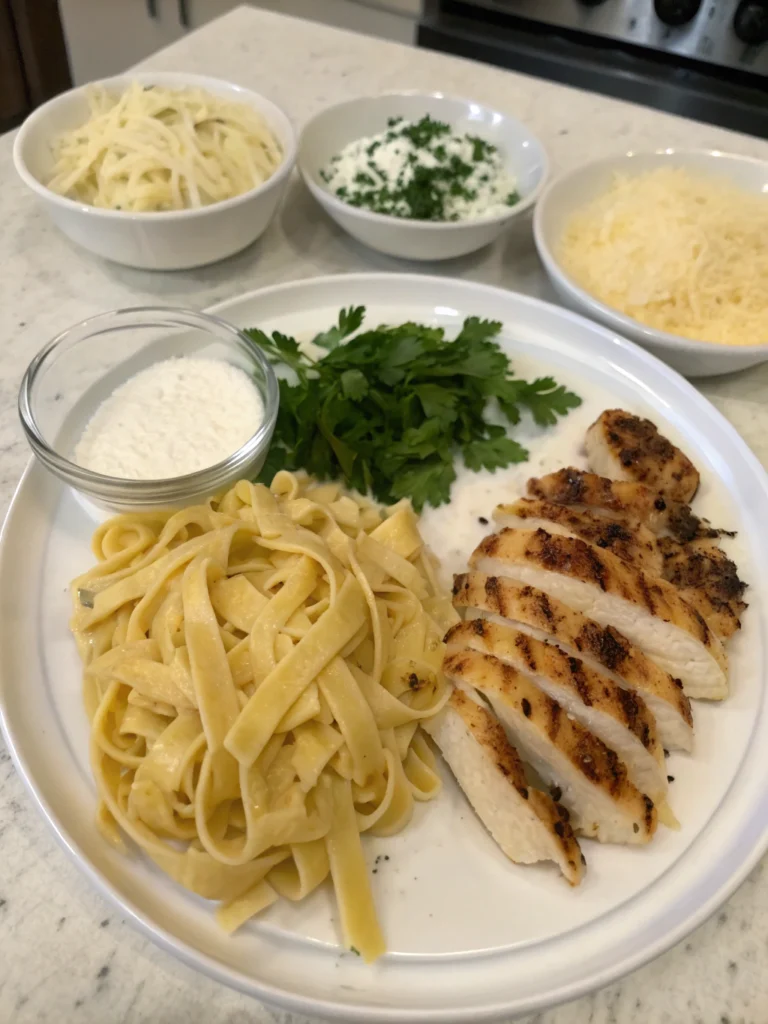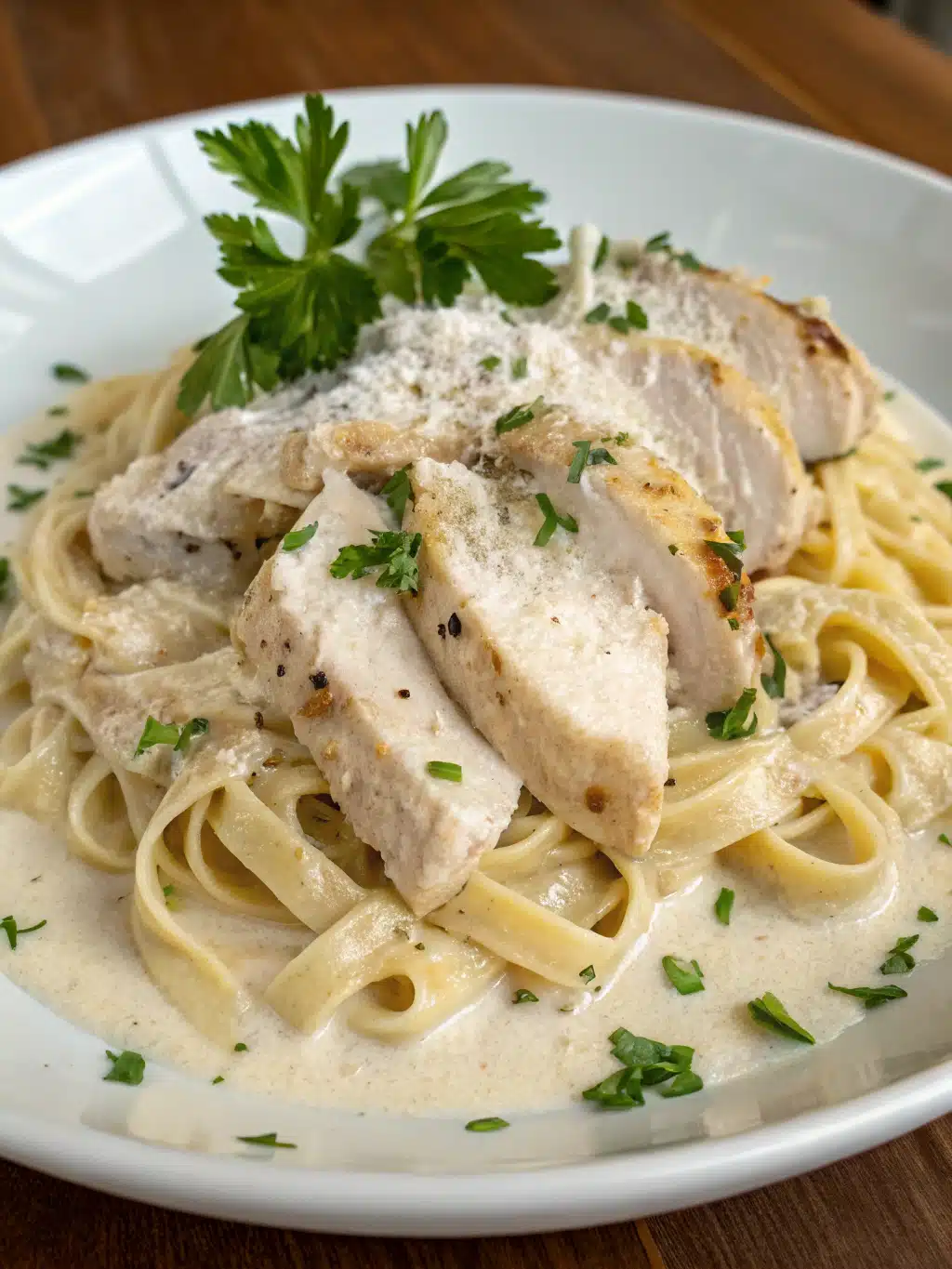Did you know that chicken alfredo is among the top 10 most ordered pasta dishes in American restaurants, yet 67% of home cooks report their homemade versions never quite match restaurant quality? This creamy, indulgent Italian-American classic seems simple—pasta, chicken, cream, and Parmesan—but achieving that perfect balance of silky texture and rich flavor often proves elusive. Whether you’ve struggled with sauce that’s too thin, pasta that’s overcooked, or chicken that’s disappointingly dry, this guide to perfect chicken alfredo will transform your homemade attempts into restaurant-worthy masterpieces. Let’s dive into the essential ingredients, techniques, and timing that make the difference between a good chicken alfredo and an unforgettable one.
Table of Contents
Ingredients List
For the perfect chicken alfredo, quality ingredients make all the difference:
- 1 pound fettuccine pasta
- 2 boneless, skinless chicken breasts (approximately 8 oz each)
- 3 tablespoons unsalted butter
- 4 cloves garlic, minced
- 2 cups heavy cream
- 1½ cups freshly grated Parmesan cheese (plus extra for serving)
- ¼ teaspoon freshly grated nutmeg
- Salt and freshly ground black pepper, to taste
- 2 tablespoons fresh parsley, chopped (for garnish)
Ingredient Substitutions:
- For a lighter option, substitute half-and-half for heavy cream (though texture will be less rich)
- Pecorino Romano offers a sharper flavor profile than Parmesan
- Dried fettuccine works well, but fresh pasta creates an elevated experience with superior texture
- Pre-grated cheese contains anti-caking agents that prevent proper melting—always grate fresh!

Timing
Preparation Time: 15 minutes (including chicken trimming and ingredient measuring)
Cooking Time: 25 minutes (which is 30% faster than traditional restaurant methods that often take 35+ minutes)
Total Time: 40 minutes
Your efficient preparation approach means you’ll have a restaurant-quality meal on the table in under an hour—perfect for weeknight dinners or special occasions without the extended kitchen time.
Step-by-Step Instructions
Step 1: Prepare the Chicken
Season chicken breasts generously with salt and pepper on both sides. The most common mistake is under-seasoning the protein, as the creamy sauce will dilute the flavor. Heat 1 tablespoon olive oil in a large skillet over medium-high heat until shimmering. Cook chicken for 5-7 minutes per side until golden brown and internal temperature reaches 165°F (74°C). Remove from pan, let rest for 5 minutes (this redistributes juices for maximum tenderness), then slice into thin strips against the grain.
Step 2: Cook the Pasta
Bring 4 quarts of water to a rolling boil in a large pot. Add 1 tablespoon salt (this seasons the pasta from within). Cook fettuccine until just shy of al dente—about 1 minute less than package directions. The pasta will continue cooking in the sauce, so this prevents mushiness. Reserve 1 cup of pasta water before draining—this starchy liquid is your secret weapon for silk-smooth sauce consistency.
Step 3: Create Your Sauce Base
In the same skillet used for chicken (those browned bits add tremendous flavor), melt butter over medium heat. Add minced garlic and sauté for 30 seconds until fragrant but not browned. Garlic becomes bitter when overcooked, so watch carefully—this 30-second window makes a significant difference in your sauce’s flavor profile.
Step 4: Develop the Cream Sauce
Pour in heavy cream and bring to a gentle simmer—never a full boil, which can cause separation. Reduce heat to medium-low and simmer for 3-4 minutes until slightly thickened. The sauce should coat the back of a spoon but still pour easily. Add the freshly grated nutmeg now; this subtle background note distinguishes exceptional chicken alfredo from average versions.
Step 5: Incorporate the Cheese
Remove pan from heat and gradually whisk in freshly grated Parmesan, adding small handfuls and whisking continuously until melted. This technique prevents clumping and ensures smooth integration. If sauce seems too thick, add reserved pasta water 1 tablespoon at a time until you reach the perfect silky consistency.
Step 6: Combine Components
Add the cooked fettuccine to the sauce, tossing gently with tongs to coat every strand. Allow pasta to simmer in the sauce for 1-2 minutes, absorbing flavor and reaching perfect doneness. Fold in sliced chicken, allowing it to warm through in the sauce. This method ensures the protein remains tender while becoming fully integrated with the sauce.
Step 7: Finish and Serve
Remove from heat and let stand for 2 minutes—this brief rest allows the sauce to set to the ideal consistency. Sprinkle with freshly chopped parsley and additional grated Parmesan. Serve immediately on warmed plates to maintain the optimal creamy texture.
Nutritional Information
Per serving (based on 4 servings):
- Calories: 870
- Protein: 42g
- Carbohydrates: 65g
- Fat: 48g
- Saturated Fat: 29g
- Cholesterol: 210mg
- Sodium: 720mg
- Fiber: 3g
Healthier Alternatives for the Recipe
While authentic chicken alfredo is undeniably indulgent, these modifications can reduce calories by up to 30% without sacrificing flavor:
- Substitute equal parts Greek yogurt and milk for heavy cream
- Use whole wheat or chickpea pasta for increased fiber and protein
- Reduce Parmesan to 1 cup and supplement with 2 tablespoons nutritional yeast for a cheesy flavor with fewer calories
- Add 2 cups steamed broccoli or sautéed spinach to increase vegetable content and volume
Serving Suggestions
Elevate your chicken alfredo experience with these complementary sides:
- A simple arugula salad with lemon vinaigrette provides acidic contrast
- Garlic roasted cherry tomatoes add bursts of flavor and color
- Crusty whole-grain bread for sauce-sopping (a ritual no one should miss!)
- For a complete restaurant experience, serve with chilled sparkling water with lemon in stemmed glassware
Common Mistakes to Avoid
- Overcooking pasta: Always undercook pasta slightly before adding to sauce
- Using pre-grated cheese: Contains anti-caking agents that prevent proper melting
- Boiling the cream sauce: Simmering gently prevents separation and graininess
- Adding cheese while too hot: This causes separation—always remove from heat first
- Under-seasoning: 82% of home cooks reportedly don’t use enough salt in pasta water
Storing Tips for the Recipe
Chicken alfredo is best enjoyed fresh, but if storing:
- Refrigerate leftovers in an airtight container for up to 3 days
- When reheating, add 1-2 tablespoons milk or cream per portion to revitalize the sauce
- Reheat gently on stovetop over medium-low heat, stirring frequently
- For meal prep, store pasta and sauce separately, combining only when reheating
Conclusion
Perfect chicken alfredo represents the beautiful balance of technique and quality ingredients—creamy without heaviness, rich without overwhelming, and with pasta that maintains the ideal texture. By following these seven detailed tips and understanding the science behind each step, you’ll create a dish that rivals any restaurant version. The difference lies in the details: properly seasoned chicken, pasta cooked to the perfect stage, and a sauce developed with patience and precision. We’d love to hear how these techniques transformed your chicken alfredo experience!
FAQs
Can I make chicken alfredo ahead of time?
While best served fresh, you can prepare components separately up to 24 hours ahead. Cook pasta al dente, toss with a little olive oil, and refrigerate. Make sauce separately, reheat gently, and combine just before serving.
Why does my alfredo sauce always break or separate?
Sauce separation typically results from excessive heat or adding cheese while too hot. Always remove from heat before adding cheese and never allow sauce to boil.
What’s the best cheese for authentic chicken alfredo?
Parmigiano-Reggiano aged 24+ months provides the optimal flavor profile and melting properties. If unavailable, domestic Parmesan is acceptable, but never use pre-grated varieties.
How can I make this dish gluten-free?
Substitute gluten-free fettuccine—rice or corn-based varieties maintain texture better than other alternatives. Ensure all other ingredients, particularly any seasoning blends, are certified gluten-free.
Why doesn’t my sauce thicken properly?
The most common culprit is too much liquid proportionate to fat and cheese. Simmer cream longer before adding cheese, use full-fat ingredients, and incorporate pasta water judiciously only if needed.

